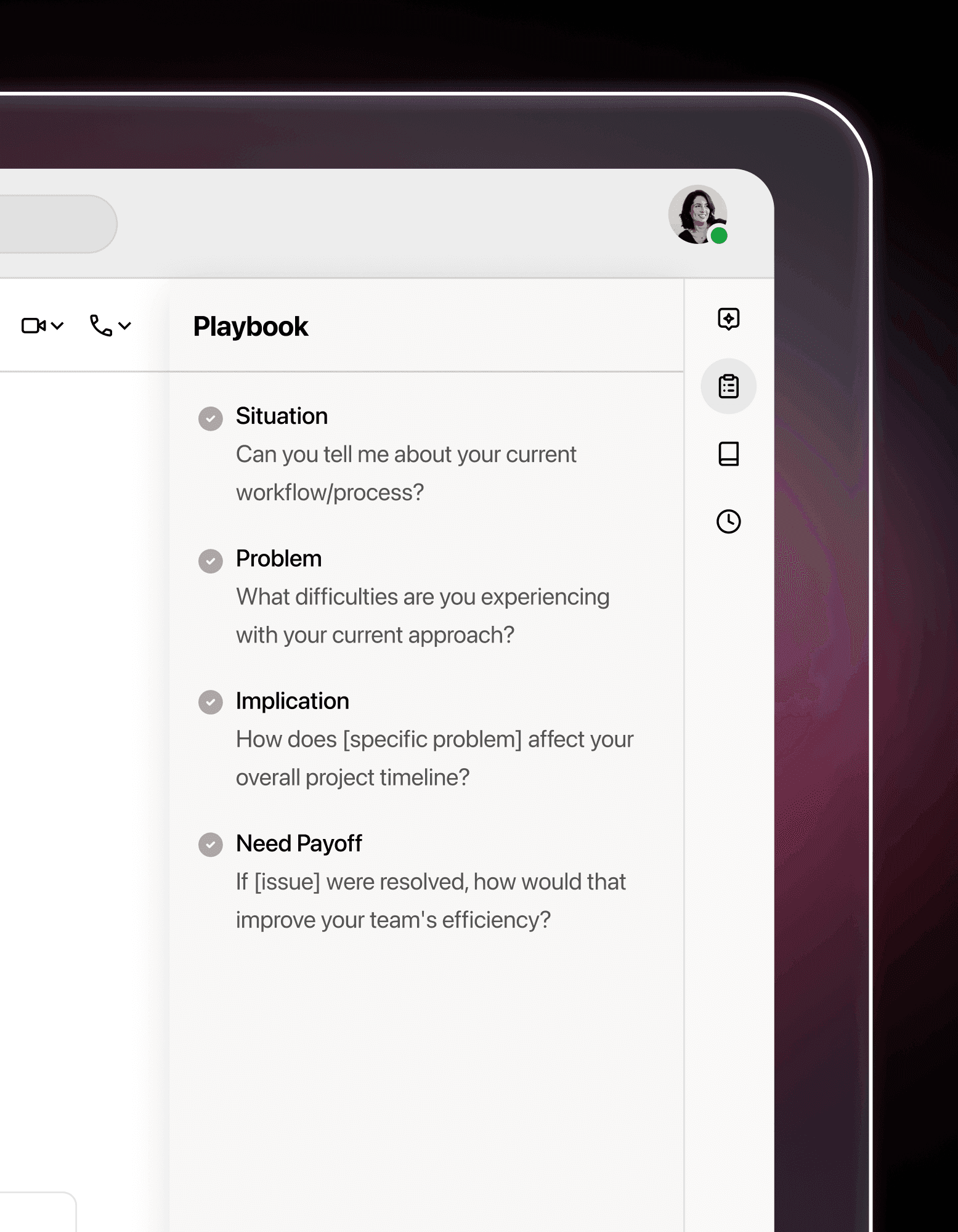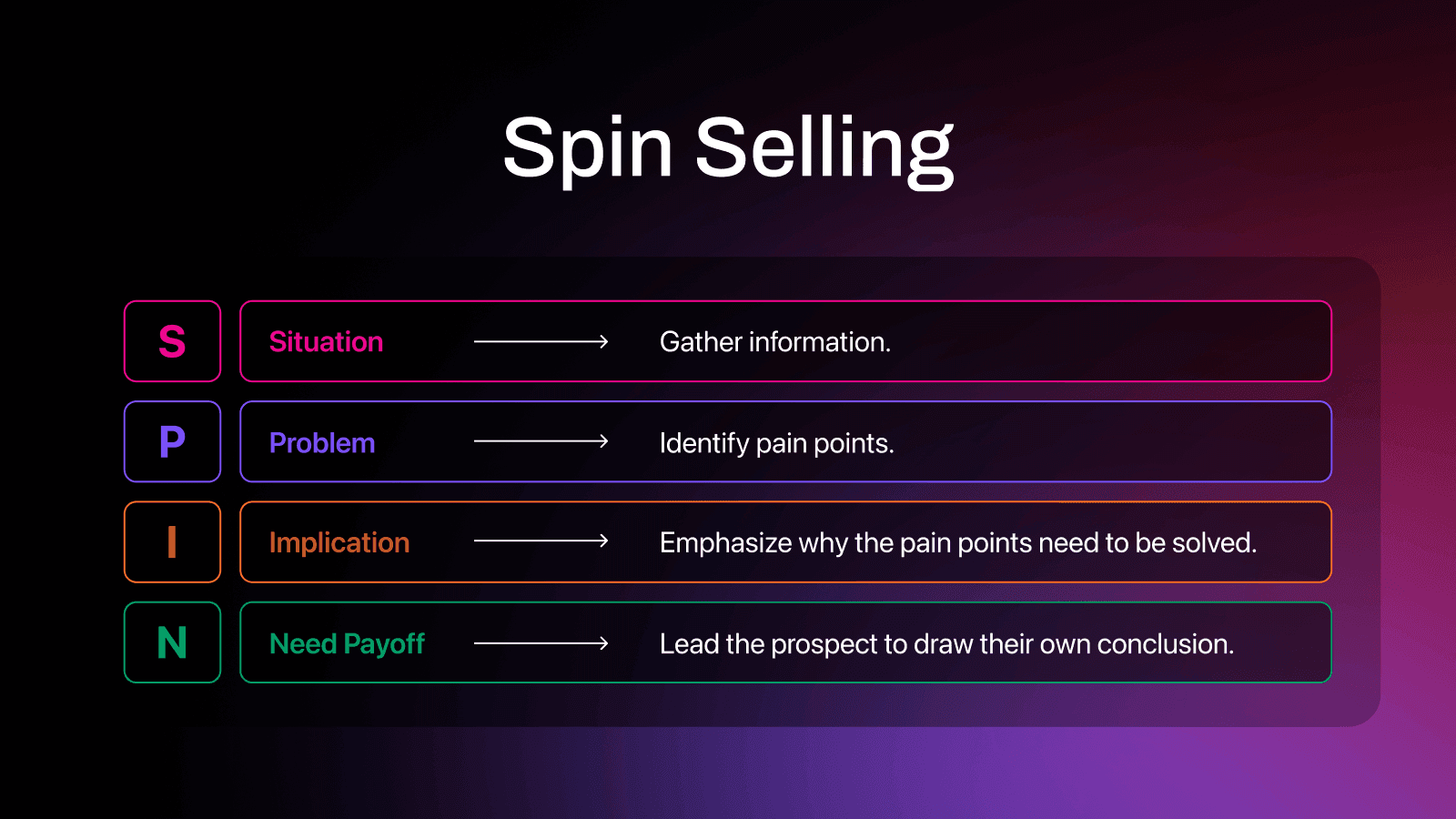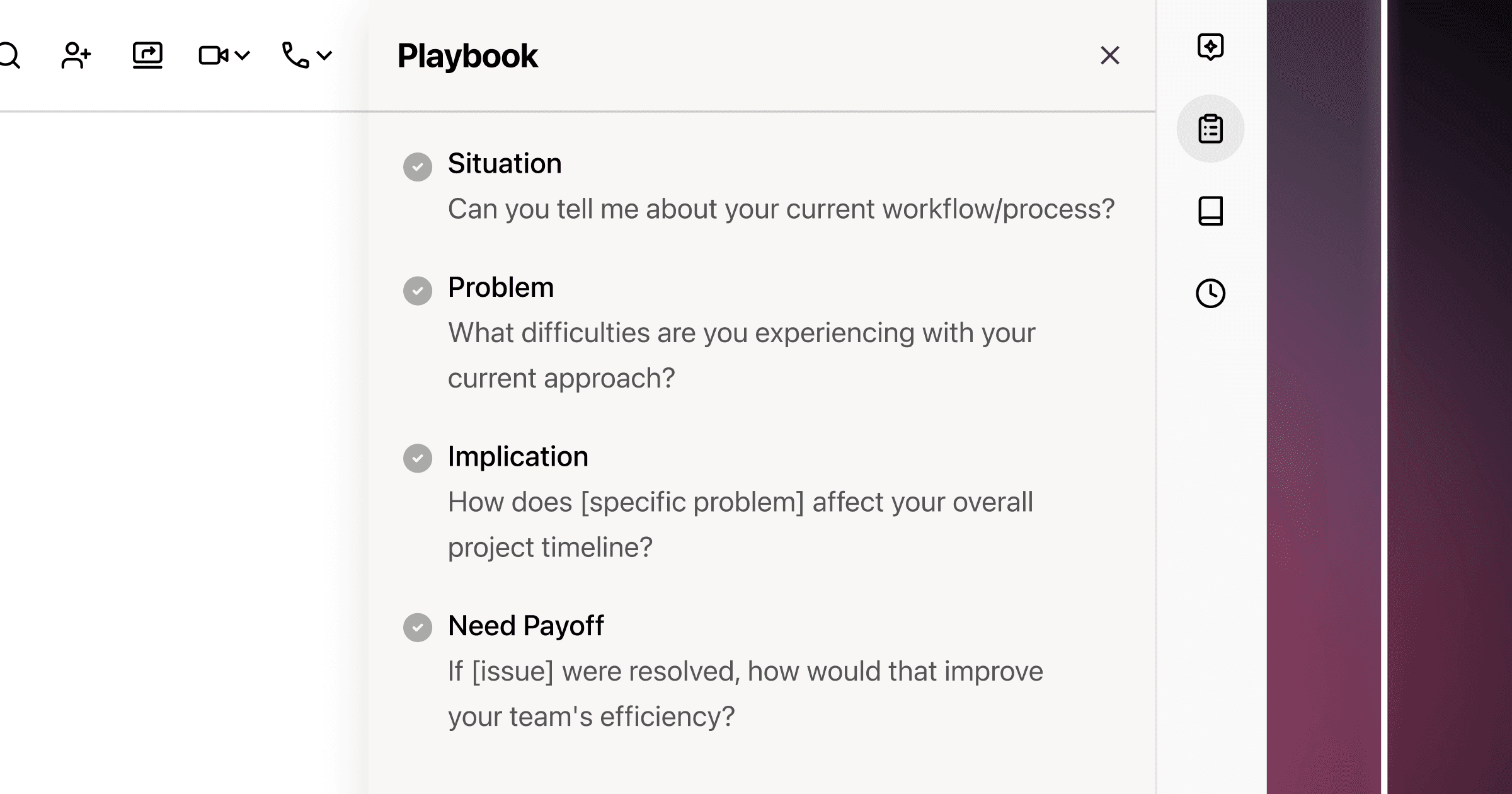SPIN sales methodology
As a sales leader, you’ve probably heard about SPIN selling. It’s one of the most-used B2B sales methodologies—and backed by research. Book a demo to learn how Dialpad's Ai Playbooks help sellers stick to SPIN as they're having conversations with prospects!

Sales is an art that demands finesse, strategy, and an understanding of human psychology. Enter the SPIN sales methodology—a powerful framework that arms sales reps with the tools to navigate complex sales cycles through a structured approach of questioning and problem-solving.
In this comprehensive guide, we’ll cover exactly what the SPIN sales methodology is, explore its four stages, and discover how to automate its implementation. We’ll also provide you with some tips that’ll help set your reps up for success.
Whether your reps are seasoned sales gurus or just stepping into the world of sales, mastering SPIN can be their ticket to sales excellence.
What is SPIN selling?
The SPIN selling methodology, contrary to any misconceptions, does not involve dizzying spins and twirls. Rather, it’s a popular sales technique developed by Neil Rackham in the late 1980s.
The SPIN methodology is based on extensive research conducted by Rackham and his team at Huthwaite, where they analyzed thousands of sales calls to identify what factors contributed to successful sales interactions. (He also wrote a book on it, if you’re interested.)
To sum it up, SPIN is a formula that empowers sales reps to decode their prospects’ needs and lead them straight to saying "yes" to the offer by building value as trusted advisors.
SPIN stands for:
Situation
Problem
Implication
Need-payoff
Each of these things is a question type that plays its own role in moving the buyer toward the sale, which we’ll go over next.
The 4 types of SPIN questions
SPIN was designed to help salespeople navigate complex sales processes by focusing on four types of questions to uncover a prospect's pain points and demonstrating how the product or service can address those pain points effectively.
Each of these questions have a purpose:

Situation questions
Purpose: Gather information.
Situation questions are like the opening lines of a detective story. You're figuring out what's happening in your prospect’s world in order to understand where they stand. These questions aim to understand the customer's current situation and gather information about their existing setup, processes, and challenges.
Some examples of situation questions could be:
"Can you tell me about your current workflow/process?"
"What tools or solutions are you currently using?"
"How do you handle [specific task/problem] right now?"
"What kind of goals are you trying to achieve?"
Problem questions
Purpose: Identify pain points.
Time to put on your problem-solving hat. You're uncovering pain points and any problems here. These questions dig into the prospect’s troubles and makes them think, "Wow, this person gets me." The goal is to uncover problems that your product or service can potentially address.
Some examples of problem questions could be:
"What difficulties are you experiencing with your current approach?"
"How often do you encounter [specific issue]?"
"What impact do these challenges have on your team's productivity?"
"Could you describe a situation where [problem] caused a setback?"
Implication questions
Purpose: Emphasize why the pain points need to be solved.
Now we're getting deep. You're helping the prospect see the consequences of their problems. These questions help the customer recognize the significance of the challenges they are facing.
Some examples of implication questions could be:
"How does [specific problem] affect your overall project timeline?"
"What happens if [issue] is not resolved?"
"Have you noticed any negative outcomes as a result of [problem]?"
"Could you explain how [challenge] might impact your team's performance?"
Need-payoff questions
Purpose: Lead the prospect to draw their own conclusion.
These questions aim to help the customer envision the benefits of solving their problems and using your product or service. They focus on positive outcomes and the value your solution can bring.
(You’re also letting them draw conclusions on their own, making your whole conversation feel less sales-y.)
Some examples of need-payoff questions could be:
"If [issue] were resolved, how would that improve your team's efficiency?"
"Can you imagine the impact of [solution] on your project's success?"
"What would it mean for your company if [desired outcome] was achieved?"
"How would [our product/service] contribute to overcoming the challenges you mentioned?"
Remember that these are just examples, and the actual questions your sales reps ask should be tailored to the specific context and needs of your potential customer. The key is to create a meaningful conversation that helps the prospect understand the value of your solution and how it can make their life easier.
The 4 stages of a SPIN sale
The SPIN Selling methodology not only involves the four stages of Situation, Problem, Implication, and Need-payoff, but it also outlines specific activities within each stage to effectively guide the sales process.
Here are the four typical phases of a SPIN sale, and how they align with the stages in the acronym:
1. Opening
This is your grand entrance. During this initial stage of the sales process, your reps will establish rapport and set the tone for the conversation. Their aim should be to create a positive and engaging interaction with the prospect. This involves:
Introducing themselves
Building a connection
Setting the agenda for the conversation
While not explicitly part of the SPIN acronym, a successful opening is crucial for a smooth transition into the investigative stage. Encourage your reps to be friendly and genuine and remind them that they’re not just selling a product, they’re building a relationship.
2. Investigating (Situation and Problem)
In the SPIN selling framework, the investigating stage aligns with the Situation and Problem stages—and is arguably the most important phase of SPIN selling. During this phase, your reps’ main goal is to gather information and understand the prospect's current situation and challenges.
Reps can ask questions (like the examples mentioned above) to uncover the prospect's pain points, needs, and existing problems. They’re essentially investigating to identify whether there's a potential fit between the prospect's needs and your product or service.
According to Rackham, doing the right research by asking the right questions can improve your close rate by 20%.
3. Demonstrating capability (Implication and Need-payoff)
The demonstrating capability stage aligns with the Implication and Need-payoff stages of SPIN selling. In this phase, your reps are showcasing how your product or service can address the prospect's identified pain points.
Your reps should present the implications of not addressing these challenges and then demonstrate how your solution can alleviate those consequences. This involves showing the prospect the value and benefits they would gain by using your product or service. (Think, FAB: Features, advantages, and benefits.)
4. Obtaining commitment
The obtaining commitment stage is where your reps seek to close the sale by gaining the prospect's commitment to move forward with your solution. This is where they transition from the investigative and demonstration phases to the closing phase.
Your reps should summarize the benefits and value they’ve discussed and ask for a commitment or next steps, like a purchase, a trial, or a follow-up meeting.
As your sales reps progress through the stages, they’ll likely find themselves circling back to previous stages as they deepen their understanding of the prospect's needs and continue to address any concerns. The goal is to engage the prospect in a consultative manner, building trust and guiding them toward a mutually beneficial solution.
After a SPIN call: Potential outcomes
A lot can happen during and after a SPIN call. Here are some potential outcomes, and what your reps should do next based on each one:
Positive commitment
What it means: This is the ideal outcome where the prospect agrees to move forward with your solution. They express interest in purchasing your product or service, signing a contract, or taking the next steps in the sales process.
Next steps: Express enthusiasm and appreciation for the prospect's decision. Provide clear instructions on the next steps, whether it's sending over a contract, arranging a payment, or scheduling an implementation process. Ensure a smooth transition from the sales conversation to the next phase of the customer journey.
Trial or demo agreement
What it means: The prospect may be interested in trying out your product or service on a trial basis. This allows them to experience its benefits firsthand before making a full commitment.
Next steps: Confirm the prospect's interest in trying out the solution and outline the details of the trial or demo. Share any necessary information, such as access instructions, trial duration, and support availability. Schedule follow-up communication to gather feedback and discuss their experience.
Request for more information
What it means: The prospect might ask for additional information, such as case studies, pricing details, technical specifications, or comparison documents. This shows their interest in exploring the solution further.
Next steps: Provide the requested information promptly. Customize your response to address their specific questions and concerns. Offer to set up a call to go over the details in greater depth or provide additional resources that can help them make an informed decision.
Objections or concerns
What it means: Objections or concerns might arise during the call. These could relate to budget, timing, compatibility, or any other aspect of the solution.
Next steps: Address objections with empathy and provide relevant information that addresses their concerns. Focus on the value and benefits that your solution offers and how it aligns with their needs.
Not a fit or rejection
What it means: In some cases, after understanding the prospect's needs and challenges, it becomes clear that your solution is not a good fit. The prospect might decide to decline moving forward with your product or service.
Next steps: Respect their decision while expressing gratitude for their time and consideration. If appropriate, inquire about the reasons for their decision, which could provide valuable insights for future interaction and leave the door open for potential future opportunities.
Positive relationship building
What it means: Even if the prospect doesn't immediately commit, if the SPIN call leads to a positive interaction, you've still succeeded in building a relationship that could lead to future opportunities.
Next steps: Express gratitude for their time and mention your interest in staying connected.
When to use SPIN selling
One thing about SPIN that makes it unique among other methodologies like BANT or MEDDIC is that it’s a lot more customer-centric. SPIN selling emphasizes understanding your prospect’s specific needs—not your sales org’s or business’ needs.
This makes SPIN an excellent methodology to use for sales reps that need to tailor their product or solution to what the prospect needs, specifically by asking need-payoff questions. For this to be possible, however, you also need a relatively longer sales cycle (e.g., you sell software or service solutions; fewer but higher ACV transactions).
When not to use SPIN selling
If you have a short sales cycle (e.g., out-of-the-box product sales; more but lower ACV transactions), on the other hand, then spending time on all those extensive SPIN questions may not be practical—or necessary.
How to automate SPIN with Dialpad’s Ai Playbooks
Now that we've cracked the SPIN code, let's see how you can put it to work.
With Dialpad’s Ai Playbooks, you can use a prebuilt playbook based on the SPIN sales methodology, that guides sales reps through live sales calls and gives managers quick and easy insights in post-sales call reviews for better training and support.

Step 1: Choose the SPIN framework template
To start, just choose the SPIN playbook template in the Ai Playbooks interface. You’ll notice that Dialpad already comes with Ai Playbooks based on SPIN, SPICED, and BANT to help sales teams speed up adoption.
Step 2: Let Dialpad’s Ai ensure SPIN adherence
Sales reps can see the Ai Playbook in real-time as they interact with prospects and customers, which will help ensure they hit all the mandatory tasks, questions, and any scripted items that are expected of them.
When a rep uses an Ai Playbook-recommended phrase or question, Dialpad’s generative Ai and speech recognition capabilities will understand that the behavior was met and check the item off the playbook’s list.
(This also helps speed up QA review for managers in post-call reviews.)
Step 3: Provide post-call coaching & support as needed
Coaches, managers, and leaders can easily see which reps are following or not following Ai Playbook behaviors to better understand who needs additional coaching and for which specific steps that are outlined.
Dialpad’s analytics and dashboards provide a detailed view of Ai Playbook adherence over time to show leaders, managers, and sales reps their improvement in specific skills.
Refining the SPIN technique: Hints, tips, and best practices to make SPIN selling work for you
The SPIN sales methodology emphasizes the importance of active listening and tailoring the conversation based on the prospect's responses. Rather than relying on a one-size-fits-all pitch, SPIN encourages salespeople to adapt their approach based on the prospect's unique needs and challenges.
Here are some tips to help your reps do just that:
Tip #1: Listen
Your prospect holds the clues. Listen carefully to their answers and adapt your questions accordingly. It's like a dance—you lead, but you also follow their steps.
Tip #2: Practice empathy
Put yourself in their shoes. Understand their world, feel their pain, and celebrate their victories. This emotional connection is the secret ingredient to SPIN success.
Tip #3: Be a storyteller
Craft stories that showcase how others have triumphed with your solution. Stories stick, statistics don't. Paint a vivid picture of success, and they'll be nodding along.
Tip #4: Keep the conversation natural
Remember, you're not reading from a script. Make the SPIN questions a part of a flowing conversation. No one likes feeling interrogated.
Put your rivals in a SPIN with a sales methodology that places customers front and center
With the SPIN sales methodology, your reps aren’t just selling—they’re crafting solutions tailored to your prospect’s needs. They’re not a pushy salesperson; they’re a problem solver, a consultant, and a friend on the prospect’s journey to success.
Automate SPIN with Dialpad’s Ai Playbooks
Contact your Dialpad sales rep to add Ai Playbooks to your Dialpad Ai Sales Center account today! Or, book a demo of Dialpad’s AI-powered sales engagement platform with our team to see how Ai Playbooks can help improve your top-line revenue.








